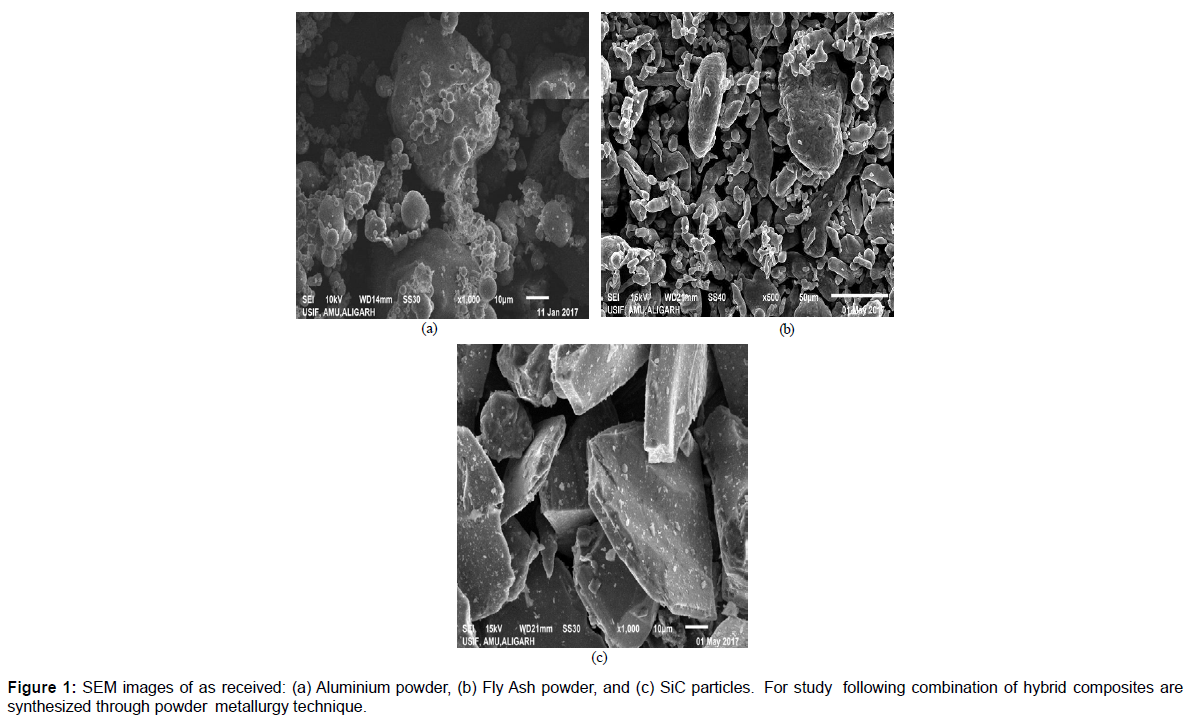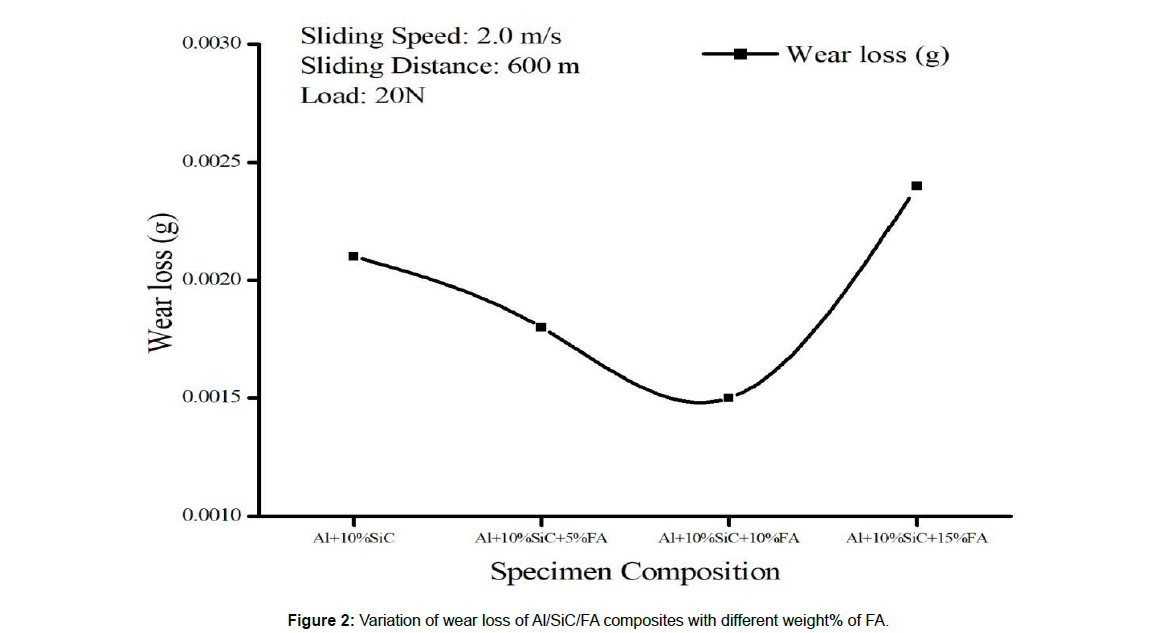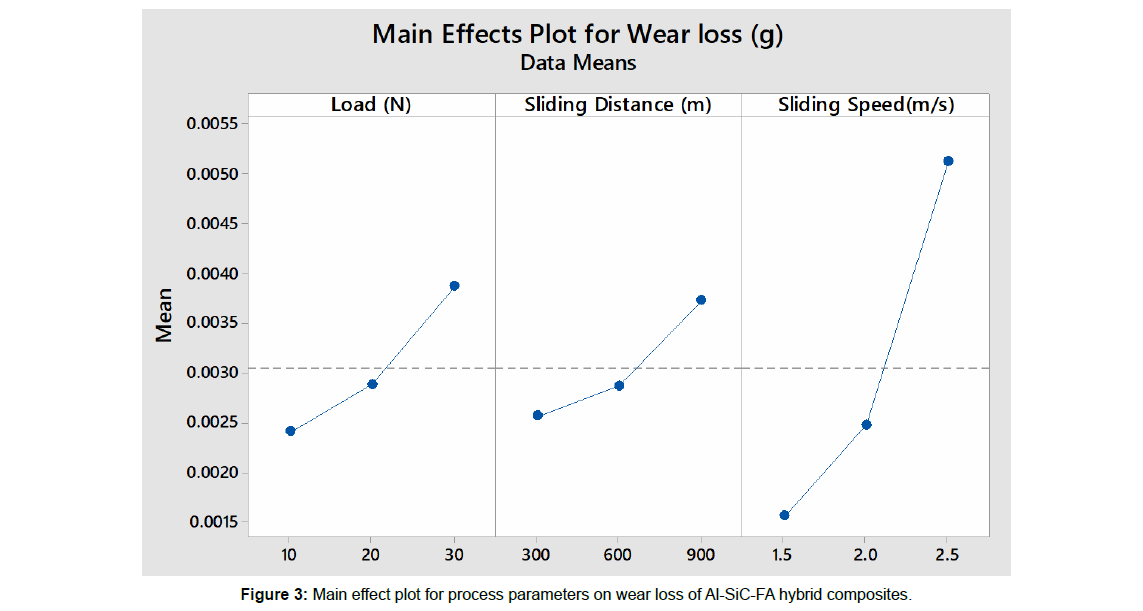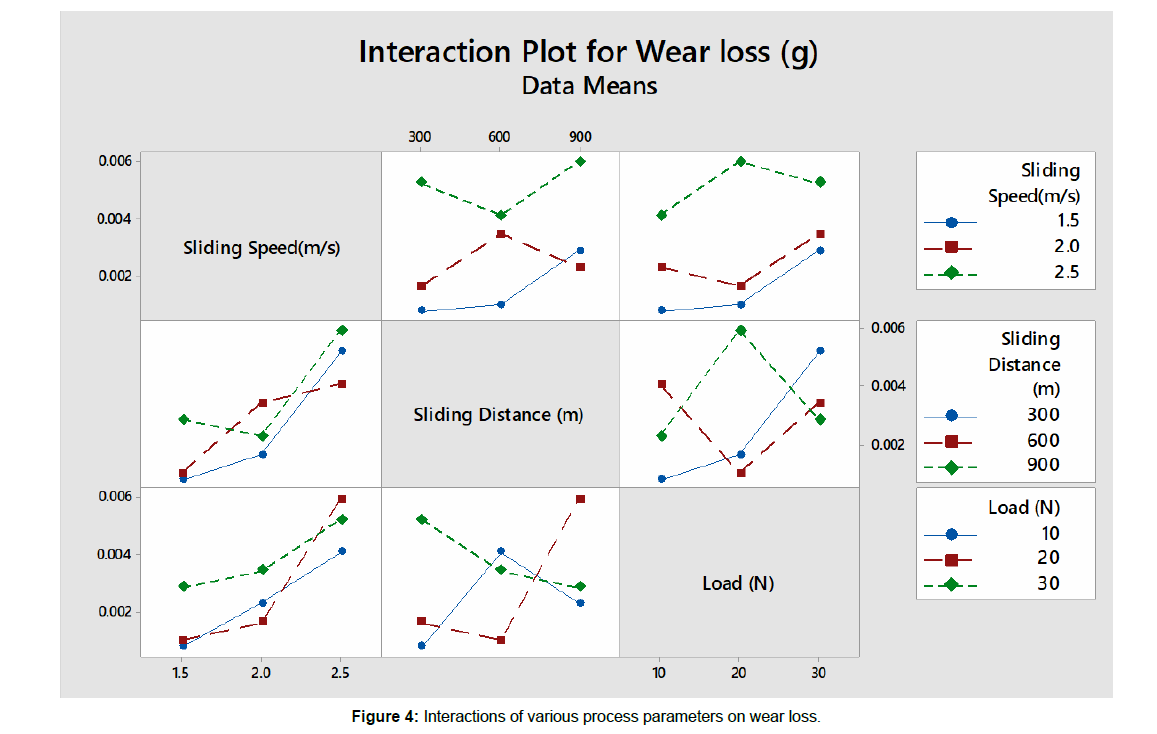A Statistical Analysis of Wear Behaviour of Fly Ash Reinforced Al-Sic Hybrid Composites
Received: 29-May-2018 / Accepted Date: 12-Jun-2018 / Published Date: 19-Jun-2018 DOI: 10.4172/2168-9806.1000190
Abstract
The tribiological behaviour of aluminium hybrid composites reinforced with Silicon carbide (10 wt.%) and Fly ash (FA 0, 5, 10 and 15 wt.%) fabricated using powder metallurgy technique was investigated. Wear tests were performed on pin on disc machine to assess the tribiological behaviour of composites and to determine the optimum volume fraction of fly ash for its minimum wear. Wear loss reduces with increase in fly ash weight fraction and minimum wear rate was attained at 10 wt.% fly ash. The influences of sliding distance, sliding speed and applied load were studied with test based on full factorial design of experiments (DOE). Analysis of variance (ANOVA) was used to evaluate the percentage contribution of each sliding wear process parameters on wear loss. From the ANOVA approach, it was concluded that wear loss is mainly influenced by sliding distance followed by sliding speed and applied load.
Keywords: Aluminium; Silicon carbide; Wear; ANOVA; Regression; Fly ash; Load; Sliding speed
Introduction
Aluminium matrix composites (AMCs) are favourable materials due to its application in automobile, structural and aerospace industries because of their properties such as high strength to weight ratio, low density, and high stiffness and wear resistance along with relatively small fabrication cost [1]. The mechanical behaviour of the metal matrix composite depends upon fabrication technique, orientation as well as distribution of the reinforced particles. Various methods like mechanical alloying, casting and powder metallurgy are used for their fabrication. Amongst the different synthesis technique, powder metallurgy found more attention due to achievement of fair homogeneity of reinforcement in matrix along with producing near net shaped products [2].
Apart from the above, there was global need of reducing the wear in order to reduce the usage of material resources and wastage of energy. This controlling of wear should be considered carefully from the basis of selecting the alloy composition, reinforcement and also the processing methods [3].
Further, aluminium reinforced with two or more reinforcements i.e. a combination of hard ceramic particles and agricultural waste/ industrial waste/natural minerals is more preferable because of improved mechanical and tribological behavior along with low production cost [4]. Amongst numerous ceramic reinforcements used in AMCs, SiC particle is most widely used because its density is very close to aluminium as well as it possesses higher stability, wear resistance and rigidity both at room and elevated temperature [5,6]. These enhancements in properties are achieved at the cost of ductility and fracture toughness. Further, addition of hard ceramic reinforcement enhances the hardness which makes machining difficult and uneconomical .In addition, fly ash particles are inexpensive, eco-friendly light weight and available in large quantities as an industrial waste. Therefore FA particles can be used as an economical reinforcement in comparison to conventionally used particles [1,7]. Previous works show an improvement in mechanical as well tribiological properties of AMCs reinforced with FA [7-10].
Further, tribiological characteristics of composites are governed by many factors like reinforcement percentage, sliding distance, sliding speed and applied load. Therefore, effect of each factor and its interaction is very important for sliding wear behaviour. For this, a statistical tool analysis of variance (ANOVA) can be used [11,12]. ANOVA method is simple, efficient and widely accepted to get quantitative measurement of each input variable on the response data.
From literature it has been noticed that no detailed findings are available on tribiological behaviour of FA reinforced Al-10%SiC hybrid composites using statistical approach. Therefore, in the current research work tribiological behaviour of Al-SiC-FA hybrid composites synthesized by powder metallurgy was explored. The effects of sliding speed, sliding distance and applied load on wear behaviour of hybrid composites were investigated using Taguchi DOE. The percentage contributions of input sliding wear parameters and their interactions were analysed using analysis of variance (ANOVA).
Materials and Experimental Details
Fabrication of composites
Pure aluminium (Al), silicon carbide (SiC) and fly ash (FA) powders were purchased. The scanning electron microscopy of as-received particles and processed FA are showed in Figure 1a-1c and Table 1.
| Sliding Speed (m/s) | Sliding Distance (m) | Load (N) | Wear loss (g) |
|---|---|---|---|
| 1.5 | 300 | 10 | 0.00079 |
| 1.5 | 600 | 20 | 0.00101 |
| 1.5 | 900 | 30 | 0.00287 |
| 2 | 300 | 20 | 0.00165 |
| 2 | 600 | 30 | 0.00347 |
| 2 | 900 | 10 | 0.00231 |
| 2.5 | 300 | 30 | 0.00525 |
| 2.5 | 600 | 10 | 0.00412 |
| 2.5 | 900 | 20 | 0.00598 |
Table 1: Composition (wt. %) of different constituents of Al-based samples.
Firstly, a digital weighing machine (Made Precisa) with a least count of 0.1 mg. was used for measuring the weight of used powders. A predetermined amount of particles was mixed thoroughly using centrifugal type ball mill. While milling, stainless steel balls were adopted with 10:1 ball to powder ratio (BPR) for the minimization of clustering as well as mechanical alloying of composite powders. The rotation speed and milling time were fixed at 100 rpm and 30 min. respectively. Further, green pallets of dimensions 8mm and height 13 mm were fabricated at 400 MPa using uniaxial hydraulic pallet press. After every compaction process the die wall was cleaned and lubricated with zinc stearate manually to ensure proper functioning of the die. The green specimens were sintered in tubular electric furnace attached with controlled environment unit. The specimens were sintered at 425-450°C for 30 min. under the continuous flow of nitrogen gas for preventing the samples from oxidation. The specimens were cooled down to the room temperature in the furnace itself under controlled environment.
Wear analysis
A pin-on-disc set-up (Ducom, Bangalore, India) was used to study tribiological behaviour of synthesized hybrid composites according to ASTM standards. The wear control variables and their respective levels are provided in Table 2. The specimens and counter disc surfaces were cleaned with acetone to eliminate adhered wear particles. The wear loss is determined by measuring weight of specimens after every test run with electronic weighing balance.
| S.No | Factor | Type | Levels | Values |
|---|---|---|---|---|
| 1. | Sliding Speed (m/s) | Fixed | 3 | 1.5, 2.0, 2.5 |
| 2. | Sliding Distance (m) | Fixed | 3 | 300, 600, 900 |
| 3. | Load (N) | Fixed | 3 | 10, 20, 30 |
Table 2: Wear variables and process parameters.
Results and Discussion
Wear loss
The wear loss i.e. wear rate for Al/SiC/FA composite was lower as compared to Al/SiC composite (Table 3 and Figure 2).
| S.No. | Composition | Wear loss (g) |
|---|---|---|
| 1 | Al-10%SiC | 0.0021 |
| 2 | Al-10%SiC-5%RHA | 0.0018 |
| 3 | Al-10%SiC-10%RHA | 0.0015 |
| 4 | Al-10%SiC-15%RHA | 0.0024 |
Table 3: Wear loss for different composition of Al/SiC/FA.
Figure 2 shows that 10 wt% of FA was the lowest wear rate at load 20N, sliding speed 2m/s and 600m sliding distance. The wear resistance of the composite was increased as compared to base matrix [1,13,14]. The unreinforced aluminium was softer than SiC and Fly ash reinforced, as shown in Figure 2. This enhancement in the wear resistance can be attributed to the following reasons: (a) High hardness imparted by Fly ash particle which restricts plastic flow during sliding condition (b) strong interfacial bond between particle and matrix phase [3-17].
Experimental design and ANOVA analysis
The experiments were performed according to Taguchi design for the Al/10% SiC/10% FA. The various control factors and their respective levels for the experiment are shown in Table 2. The Taguchi design having 9 rows and 3 columns is shown in Table 4. The results of all 9 set of experiments were subjected to analysis of variance (ANOVA). All the result tables and plots are calculated with the help of Minitab-18 software (Tables 4 and 5).
| Sliding Speed (m/s) | Sliding Distance (m) | Load (N) | Wear loss (g) |
|---|---|---|---|
| 1.5 | 300 | 10 | 0.00079 |
| 1.5 | 600 | 20 | 0.00101 |
| 1.5 | 900 | 30 | 0.00287 |
| 2 | 300 | 20 | 0.00165 |
| 2 | 600 | 30 | 0.00347 |
| 2 | 900 | 10 | 0.00231 |
| 2.5 | 300 | 30 | 0.00525 |
| 2.5 | 600 | 10 | 0.00412 |
| 2.5 | 900 | 20 | 0.00598 |
Table 4: Taguchi based design for wear experiment for Al/SiC/10%FA.
| Source | DF | Adj SS | Adj MS | F-Value | P-Value | Percentage |
|---|---|---|---|---|---|---|
| Sliding Speed (m/s) | 2 | 0.00002 | 0.00001 | 34.44 | 0.028 | 74.07 |
| Sliding Distance (m) | 2 | 0.000002 | 0.000001 | 3.63 | 0.216 | 7.4 |
| Load (N) | 2 | 0.000003 | 0.000002 | 5.57 | 0.152 | 11.11 |
| Error | 2 | 0.000001 | 0 | 3.7 | ||
| Total | 8 | 0.000027 |
Table 5: Results of ANOVA for wear loss (g)
To find influence of each process parameter on wear behaviour of synthesized composites ANOVA have been performed and shown in Table 5. The sliding speed is showing highest effect on wear loss and contributing 74.07% while applied load (11.11%) and sliding distance (7.4%) contributed a lesser amount to the wear loss. The error contribution is 3.7% only. Since interaction effect contributed a very lesser amount so it is not shown in the table (Figure 3).
Effect of different process parameters on wear loss
The effect of each process parameter (sliding speed, sliding distance and applied load) on wear behaviour can be analysed with the help of main effect plot and interaction plot. Figure 3 is main effect plot and is showing the effect of process parameters on the wear loss. According to the ANOVA, if the slope of any process parameter in the main effect plot is lower to the mean value, then it concludes that the given process parameter has no significant effect. On the other hand, process parameter whose plot has the highest slope is most significant. So, it is clear from the main effect plot that the sliding speed is the most Influential parameter followed applied load and sliding distance. The main effect plot also shows that as there is increase in sliding speed, sliding distance and applied load aluminium composites its wear resistance decreases (Figure 4) [12-19].
Figure 4 presents the two way interaction plot for coefficient of friction. If the lines are non-parallel then it shows an interaction between the factors while the line crossing each other shows a strong interaction between the factors. Hence, in Figure 4, plot depicts that lines are non-parallel and crossing each other. It can be stated that interaction takes place but overall effect is little as compared to the main effects [1,20].
Conclusion
The following major conclusions can be drawn by using statistical approach on Fly ash reinforced Al-10%SiC hybrid composites fabricated by powder metallurgy technique.
1. The Al/SiC/FA composites have been successfully fabricated by the powder metallurgy route for study on the tribiological properties.
2. The wear resistance of the composites increased with addition of the Fly ash particle content. The wear rate at 10 wt.% FA reinforced Al/SiC is lowered by 28% of the wear rate for the Al/ SiC material.
3. The wear behaviour increases with increasing velocity, sliding distance and load during sliding.
4. ANOVA analysis provided the exact amount of percentage contribution of each factor on wear loss: Sliding speed (74.07%), applied load (11.11%) and sliding distance (7.4%) in the composites.
References
- Nurani SJ,Saha CK (2015) Aluminium Composites and Further Improvement in Their Tribological Properties - A Review. J Mod Sci Technol 3: 183-192.
- Sharifi EM, Karimzadeh F (2011) Wear behavior of aluminum matrix hybrid nanocomposites fabricated by powder metallurgy. Wear 271: 1072-1079.
- Manikandan M, Karthikeyan A (2014) A Study on Wear Behaviour of Aluminium Matrix Composites with Ceramic Reinforcements. J Sci Res 22: 128-133.
- Padmavathi KR, Ramakrishnan R (2014) Tribological behaviour of aluminium hybrid metal matrix composite. Procedia Eng 97: 660-667.
- Alam MT, Arif S, Ansari AH (2017) Mechanical Behaviour and Morphology of A356/SiC Nanocomposites Using Stir Casting. IOP Conf Ser Mater Sci Eng
- Shaikh MBN, Arif S (2018) Fabrication and characterization of aluminium hybrid composites reinforced with fly ash and silicon carbide through powder metallurgy. IOP Conf Ser Mater Res Express.
- Manojkumar M, Ramachandran SP (2016) Wear Characteristics of Hybrid Al 6063 Matrix Composites Reinforced with Graphite and Fly Ash Particulates. Appl Mech Mater 854: 1-9.
- Ramachandra M, Radhakrishna K (2007) Effect of reinforcement of flyash on sliding wear, slurry erosive wear and corrosive behavior of aluminium matrix composite. Wear 262: 1450-1462.
- Yadeem JM, Krishna G (2015) Design, Fabrication, Characterization and Deformation Studies of Fly ash/SiC Reinforced AA2024 Composites. Int J Mech Ind Technol 3: 258-268.
- Bahrami A, Soltani N, Canul MI, Gutierrez CA (2016) Development of metal-matrix composites from industrial/agricultural waste materials and their derivatives. Crit Rev Environ Sci Technol 46: 143-208.
- Rana RS, Purohit R, Sharma AK, Rana S (2014) Optimization of Wear Performance of Aa 5083/10 Wt. % Sicp Composites Using Taguchi Method. Procedia Mater Sci 6: 503-511.
- Uthayakumar M, Kumaran ST, Aravindan S (2013) Dry Sliding Friction and Wear Studies of Fly Ash Reinforced AA-6351 Metal Matrix Composites Dry Sliding Friction and Wear Studies of Fly Ash Reinforced AA-6351 Metal Matrix Composites. Adv Tribol pp 1-6.
- Dinaharan I, Nelson R, Vijay JS, Akinlabi ET (2016) Microstructure and wear characterization of aluminum matrix composites reinforced with indstrial waste fly ash particulates synthesized by friction stir processing. Mater Charact 118: 149-158.
- Swaminathan G, Prasad AR, Suresh SM, Vignesh C (2016) Experimental Analysis of Hardness and Densification of Microwave Sintered AL/SIC/AL2O3/Flyash Composites. Indian J Sci Technol 9: 1-6.
- Das DK, Mishra PC, Singh S, Thakur RK (2014) Properties of ceramic-reinforced aluminium matrix composites - a review. Int J Mech Mater Eng 9: 1-16.
- Wang H, Zhang R, Hu X, Wang CA, Huang Y (2008) Characterization of a powder metallurgy SiC/Cu-Al composite. J Mater Process Technol 197: 43-48.
- Kumar TS, Subramanian R, Shalini S, Anburaj J, Angelo PC (2016) Synthesis , microstructure and mechanical properties of Al-Si-Mg alloy hybrid (zircon+alumina) composite. Indian J Eng Mater Sci 23: 20-26.
- Sarada BN, Murthy PLS, Ugrasen G (2015) Hardness and Wear Characteristics of Hybrid Aluminium Metal Matrix Composites Produced by Stir Casting Technique. Mater Today Proc 2: 2878-2885.
- Ravindran P, Manisekar K, Narayanasamy R, Narayanasamy P (2013) Tribological behaviour of powder metallurgy- processed aluminium hybrid composites with the addition of graphite solid ... aluminium hybrid composites with the addition of graphite. Ceram Int vol 39: 1169-1182.
- Singh J, Chauhan A (2015) Characterization of hybrid aluminum matrix composites for advanced applications – A review. J Mater Res Technol 5: 1-11.
Citation: Shaikh MBN (2018) A Statistical Analysis of Wear Behaviour of Fly Ash Reinforced Al-Sic Hybrid Composites. J Powder Metall Min 7: 190. DOI: 10.4172/2168-9806.1000190
Copyright: © 2018 Shaikh MBN. This is an open-access article distributed under the terms of the Creative Commons Attribution License, which permits unrestricted use, distribution, and reproduction in any medium, provided the original author and source are credited.
Select your language of interest to view the total content in your interested language
Share This Article
Recommended Journals
Open Access Journals
Article Tools
Article Usage
- Total views: 5322
- [From(publication date): 0-2018 - Dec 21, 2025]
- Breakdown by view type
- HTML page views: 4274
- PDF downloads: 1048




